top of page

Photography
Photography

Nature in the Cache: A Paradise for Nature Photographers
by Michael Jeffords
As a biologist who photographs, I am intimately familiar with the creatures that inhabit the Cache River Ecosystem. Its herons, egrets, prothonotary warblers and ancient cypress trees populate epic landscapes worthy of anyone's admiration. But, for those who seek experiences beyond the trophy, signature photographs so prevalent in magazines today, the Cache provides a wealth of challenging and significant photographic opportunities:
- Visit the Lower Cache Access during early morning or late afternoon and bring a tripod. Most any lens will do if you take a series of overlapping images to create spectacular panoramic views of this primeval landscape. (Photo 1)
- Walk behind the Cache River Wetlands Center to the bridge over the Cache. If you are quiet, you may surprise several dozen turtles shingled on a single log. (Photo 2)
- Take an off-the-beaten-path drive to Hickory Bottoms in Cypress Creek National Wildlife Refuge for a chance to see and photograph the uncommon Appalachian eyed brown butterfly. While there, shoot the utterly wild landscape that is the mature, lowland forest. (Photos 3 and 4).
- In fall, a hike along the Tupelo Trail to Little Black Slough will yield images of the Midwest’s best flower show—swamp marigolds literally carpeting the ancient swamp. (Photo 5)
- A trip to Wildcat Bluff may yield views of the uncommon goatweed butterfly, the brilliant neck patch of an eastern fence lizard or an eye-level view of a black vulture roost. (Photos 6, 7, 8)
In short, the list of photographic opportunities in the Cache is virtually limitless. I have been coming here to photograph for over 40 years, and each and every trip yields a new and different photographic endeavor. Enjoy!
bottom of page







